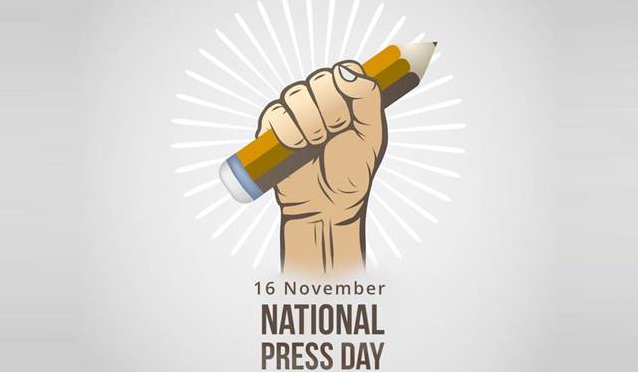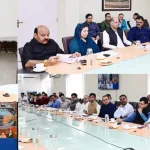With the American elections having concluded few days back & the ‘ambivalent personality’ i.e. Donald Trump riding on the crest of a sympathy wave garnered owing to an attempted assassination bid having captured the covetous seat of the most powerful man of this planet (US President), it seems that the world has gravitated to the most important man and his utterances. But then famous poet ‘Oscar Wilde’ had this to say—quote –‘In America, the president reigns for four years and journalism governs forever and ever’-unquote. Having uttered this stark fact more than a century ago, it still remains a gospel truth today irrespective of the fame of the governing lot. The 4th pillar of democracy i.e. a free press is the typical ‘sine quo non’ of a thriving and throbbing nation which is fed on non-partisan coverage of happenings in that country. An absence of this essentiality of a democracy spells doom sooner or later for the country.
Welcome to the ‘National Press Day ‘of India which is ringed every year on 16th November with the same gusto that once set the ball rolling by the famous PCI (Press council of India) way back in circa 1966. Since that year this celebrated occasion has always been surrounded by a halo depicting a typical theme which goes to underscore the dominant thinking of that particular year. The year of 2024 ushers in the spirit of ‘Press freedom, truth and ethical journalism’. ‘National Press Day’ highlights the essential role that the press plays in a democratic society. The commemoration of this event acknowledges the press’s duty to report truthfully, hold power accountable and nurture a well-informed public of the nation.
This influential event was established by the ‘Press Council of India’ in 1966 with the meaningful aim of highlighting the role of media in defending democracy and promoting transparency. The PCI is a regulatory body that is dedicated to being the ‘Standard-bearer’ of journalistic ethics and ensuring of freedom of expression. It is a day of deliberation and assessment for the Indian press as it aspires to protect public interest and maintain credibility in an era of fast changing ‘societal and press mores’.
The history of press In India dates back to the colonial era when the first newspaper was established. The Indian press developed and expanded significantly in the 19th century, while playing a vital role in promoting awareness and building a nationalistic sentiment. ‘Raja Ram Mohan Roy’ contributed to the freedom of press by founding ‘Sambad Kaumudi’ and supporting free expression, challenging British censorship and supporting social reforms.
Publications like ‘The Hindu’, ‘Amrit Bazar Patrika’ and ‘Kesari’ helped to motivate and arose public opinion against British colonialism. It was in March 1868, that three Bengali brothers –Hemant Kumar Gosh, Sishir Kumar Gosh and Motilal Gosh left their government services and established the now famous ABP (Amrit Bazar Patrika) from Jessore now in Bangladesh. This seminal newspaper was partially published in English and partly in Bengali as a ploy to garner the support of both the language aficionados and build a groundswell of support for the Indian independence. Who can forget the all too sensational news broken by this newspaper of a British calumny and perfidy to malign the Maharaja of Jammu & Kashmir Pratap Singh by spreading canards about the ruler siding with the Russians during the height of the infamous ‘Great Game’ and their bid to dethrone him? It all too happened with the tacit approval of Lord Lansdowne the then Vice Roy of India which was published on the front pages of this newspaper in the late 19th century.
The first newspaper in India was Hicky’s ‘Bengal Gazette’ launched by James Augustus Hicky in 1780. This weekly newspaper published in English at Calcutta (now Kolkata) functioned as a critical voice against British colonial rule and laid the foundation stone for ‘India’s press’ as we see it today setting a precedent for using journalism as a tool for truth and resistance. James Augustus Hicky is often remembered as the ‘Father of Indian Press’ for introducing journalism in the sub-continent. Though his paper was eventually shot down due to censorship, nevertheless his contributions set the tone for future Journalistic forays of Indians on the news front.
Similarly the first Hindi newspaper in India was ‘Udant Martand’ published in 1826 by Pandit Jugal Kishore Shukla, which too was based at Calcutta and primarily served the interests of the Hindi speaking Indians. Freedom fighters and leaders like Mahatma Gandhi, Jawaharlal Nehru , Bal Gangadhar Tilak used the power of the press to reach and mobilize crores of Indians during the hey days of the struggle for independence. Gandhi himself edited ‘Young India’ & ‘Harijan’ using these publications to broadcast his ideas on non-violence, truth and Swaraj (self –rule). This era catapulted the national mood of despondency to that of a throbbing India all set to lift off the yoke of foreign rule.
So far so good. But what is the state of the fourth pillar of democracy in today’s India? Does it portray a rosy picture in its long journey starting from its humble beginnings more than two centuries ago? ‘I have resigned’ the journalist declared in a ‘YOU TUBE’ video last November, exactly a year back. ‘You won’t hear me on NDTV any more saying,–‘Hello I am Ravish kumar’. And with that the long time face of New Delhi Television’ one of the oldest news broadcasting channels stepped down. Ravish, all of 48 years of age had been with NDTV for 26 years and was helming as the executive director at the news outlet known for its fierce and critical coverage of government policies and citizen’s voices. But since last August, when Gautam Adani, a controversial business magnate, announced his move to acquire the channel in a hostile takeover, anxiety grew in the newsroom of NDTV as did the departure of network leaders like Ravish.
Conglomerate take overs of media outlets are not unique to India. But off late many independent journalists have gone on record to say that Indian media takeovers are symptomatic of a larger malaise posing a threat to the centuries old independence of the so called ‘Fourth pillar’ of democracy. Similarly in 2014 , NDTV’s biggest competitor ‘Network -18’ was acquired by Mukesh Ambani another business magnate of reckoning thus making him control more than 70 outlets across the country with a combined weekly audience of more than 800 million viewers. That extrapolates to more than 80% of total population of India, selling the majoritarian populist agenda. What is left is a few major (digital) outlets that are independent and a silver lining in an otherwise orchestrated news peddling.
As per the ‘World Press Freedom Index’ published annually by ‘Reporters Sans Borders’ ( RSF), India ranked 159th in this year’s rankings lower than even countries like Pakistan and Sri Lanka who were 152 and 150 respectively. Can the above figures be in consonance with the nation states who were formed on the basis of theocracy and ruled as such by theocrats vi-a-vis with a country like India who has been always championing the cause of the equitable justice in a society through its press fraternity? But then coming from a reputable organization like the RSF, one has to be humble enough to acknowledge the slide which the press has taken off late in India. India’s ranking was 161 out of 180 countries last year. The index ranks 180 countries on the ability of journalists to work and report freely and independently.
In the Asia Pacific region– the world’s second most difficult region for practicing journalism –five countries are among the world’s ten most dangerous countries for media personnel: Myanmar (171), China (172), North Korea (177), Vietnam (174) & Afghanistan (178). But unlike last year none of the region’s countries are in the index’s top 15. It is important to note that India has been consistently ranked over 100 since 2003, which means that not all muck can be dumped on the door steps of the present Modi dispensation. A lot of this blame has to be apportioned amongst the previous governments too who used this fourth pillar of democracy as a convenient handle to whip up a frenzy of sorts in their favour as also to indulge in frequent witch hunting when the going seemed rough in matters concerning good governance.
The real nose-dive for journalistic survival cum thriving was in the decades preceding the infamous days of emergency and also during the said period unleashed by a vengeful Mrs Gandhi against her detractors setting in the bargain some of the darkest stains on the democratic firmament of India. Since those dark days of ‘Emergency’ lot of water has flown down the river Ganges to be holding those tumultuous days as the proverbial ‘Casus belli’ between the three pillars of democracy against the fourth pillar. The danger for the fourth pillar albeit has metamorphosed in myriad other forms that needs a constant evaluation and ways to overcome them.
It is here that the role of a statutory body like the prestigious PCI (Press Council of India) comes into play which was established under the ‘Press Council Act, 1978’ with the primary aim of safeguarding press freedom and to improve the standards of newspaper reporting in India. With 28 members in this august body, the PCI represents a diverse array of sectors to include working journalists, newspaper management sector, news agencies, parliament representatives (numbering five) and lastly three members from the fields of education, law and literature.
The constitution of India guarantees ‘Freedom of press’ as part of the ‘right to freedom of speech and expression’ under article 19(1) (a). This right however is tempered with reasonable restrictions outlined in article 19(2). Despite these express laws governing press freedom, we have seen media platforms facing pressures from political and now business fraternity to do their bidding. Certain challenges that have been the wont of press in India are as under—
- Media ownership & bias.
- Censorship & threats to journalists.
- Misinformation and fake news.
- Economic pressures.
Unless the above are fairly and squarely dealt with a heavy hand, the freedom of press will be chimera for times to come. The present newspaper from where I am writing this column i.e. the ‘Rising Kashmir’ paper is a living testimony of facing journalistic danger in all its hues, when its chief editor Mr. Shujat Bukhari was shot dead by the renegade elements of the society few years back to muzzle the voice of a free press and journalistic ethics. What more can a newspaper offer for standing fast to its convictions?
(The writer is a regular scribe of Rising Kashmir and can be approached on his email: [email protected])








